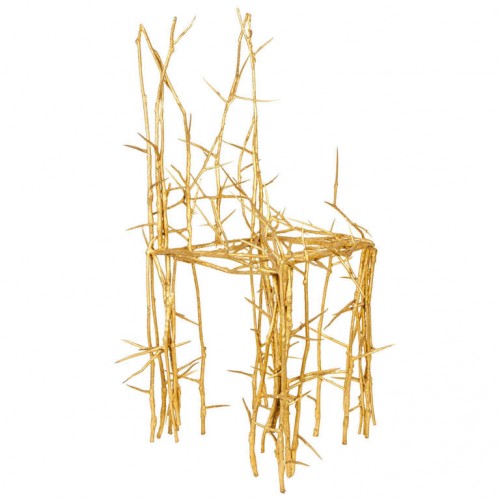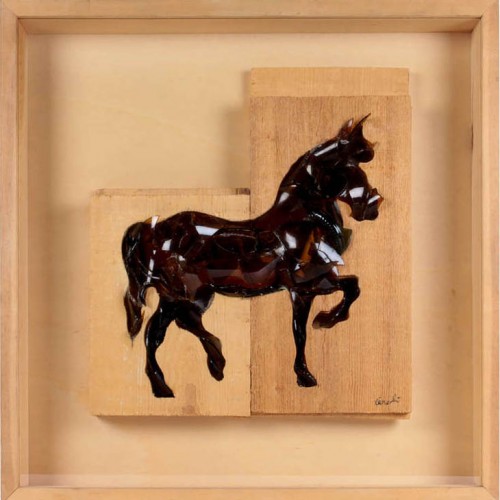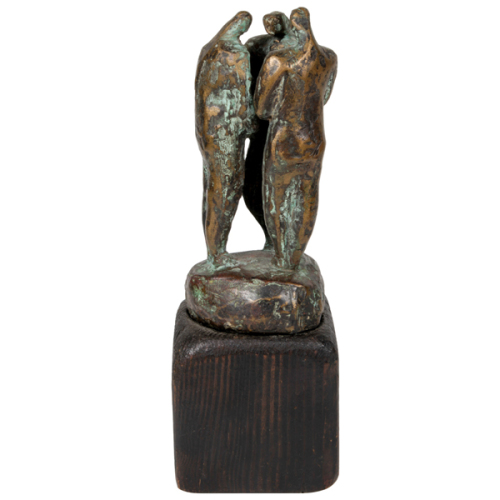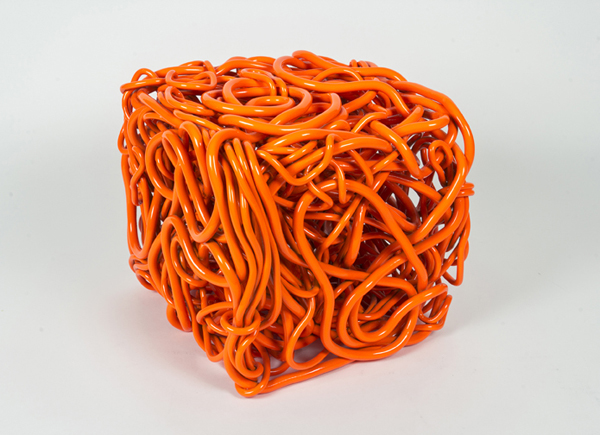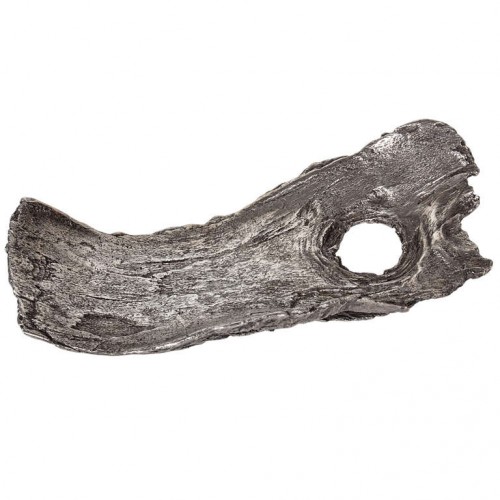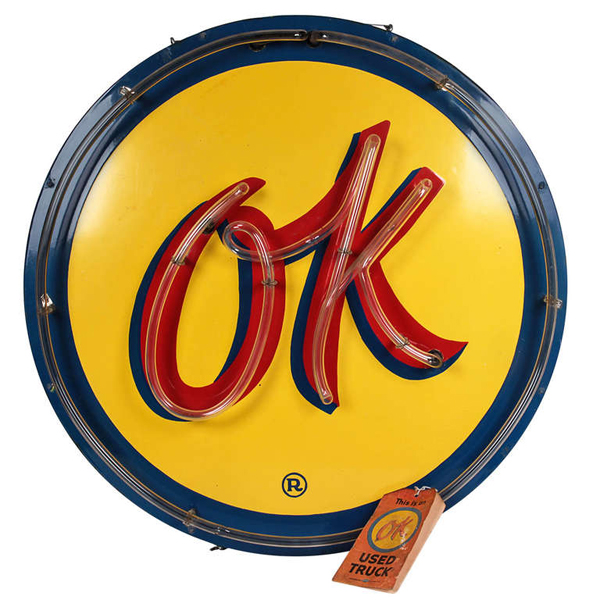Post-War to Present Sculpture

Post-War to Present Sculpture
-
Michele Oka Doner Terrible Chair sculpture (unique) 1981
MICHELE OKA DONER (b. 1945) USA
Terrible Chair (unique) 1981
Gilded bronze
Illustrated: Michele Oka Doner, Natural Seduction, S. Ramljak, M. Lapidus, A. C. Danto (New York: Hudson Hills Press, 2003), p. 85
H: 31 ½” x W: 15” x D: 17 ½”
Excerpt from “The Furniture of the Universe” by Arthur C. Danto in Michele Oka Doner: Natural Seduction (New York: Hudson Hill Press) 2003 p. 30
The Terrible Chair
What drew me initially to the work of Michele Oka Doner was the way it acknowledges the rhetoric of sitting and the metaphorical language of furniture and, most particularly, of the chair. Consider, for examples, the work she calls Terrible Chair which a distant affinity to Adirondack furniture as it is cast from a prototype fashioned out of branches. The Adirondack chair itself refers more directly to the forest; it is made of branches and looks as If nothing more than an axe or a hunting knife were needed to construct it. It proclaims the skill of the woodsman prevailing over the forest by seeing it in terms of opportunities for survival rather than representing threats and dangers. The Adirondack chair is a domesticated tree, a bower and as much a testament to the superior power of the seated as a chair with clawed or hoofed legs, in which we sit as master over beasts. The proper habit for it is the hunting lodge, with bearskin rugs suitably prone on the look or the long veranda of a mountain chalet.
Terrible Chair is made of thorned branches, which have a certain menacing beauty but no real use unless to fashion a mocking crown. Oka Doner is drawn to natural objects; they are her models and her motifs, the source of her metaphors. She saw a thorny branch that she found on a neighbor’s property a clear challenge: “The way the thorns were arranged was exquisite,” she recalled. But those same thorns were too threatening to invite physical approach. A thorned plant has an evolutionary advantage because it refuses to yield to human use. This was an irresistible dare to an artist bent on turning the natural into the meaningful.
Terrible Chair is a victory; it defines what it means to be an artist in Oka Doner’s conception of that role. It is equally a victory for the thorns because the utility promised by the chair they form remains unavailable to sitters: the thorned sticks are available only as art but not for use. The radical unusability of the work constitutes a draw in the match with nature, and the bronze in which it is cast forms a suitable monument to that context. Terrible Chair enshrines an objective contradiction.Nonetheless, the components of the Terrible Chair are combined to form a chair, but because there is no seat, no one would know how to use it in a conventional way. There have been treacherous chairs that have concealed their treachery, subverted the confidence shown in the act of sitting—chairs that collapse beneath their users, The Marquis de Sade offered chairs to female sitters that rotated them through an abrupt arch onto their backs and into a position of sexual accessibility from vertical dignity to horizontal vulnerability. By contrast, no one is tempted to sit on a Terrible Chair so dignity is at least not put in threat. So what is its meaning? In its outward inhospitality, the work says, in effect, “This chair is not for sitting.” It has to have the form of a chair to deliver this message. It excludes the chair from use as if to underscore the message, it excludes the chair from use as if to deliver the truth that chairs count in the game of meanings, transmitting auras to their occupants. It acquires a fairy tale inaccessibility like the glass slipper in Cinderella into which only the tiny foot of a natural princess can slip. Terrible Chair— a name, the artist told me, her two sons helped select—promises to transform whoever claims it. But clearly we are not its intended occupants. So it stands as a reminder of the higher meanings of chair to those who may have relegated them to the drab language of utility. Through its thorny point, brandished like the spikes on medieval armor, Terrible Chair transfers itself the power that sitting in it would confer.
I think of Terrible Chair as Oka Doner signature work, transmitting the message through its sharp spins that although she makes chairs, she is no a designer but an artist. And though the chair is part of the domestic lexicon, her project is to bring meaning rather than comfort. Should her work provide comfort, it is an incidental by-product of a class that acknowledges human needs but transform their satisfaction into symbolic acts and cosmic endorsements. Gesturing toward the spiky, spiny objects that furnish her tremendous loft—transfigurations of natural forms cast in various metals that carry their own system of meanings—Oka Doner draws attention to the fact that nothing here is upholstered. She likes the hard, the skeletal, the pronged and edgy armature of carapace, the natural scaffoldings t hat give shape and structure to the vulnerabilities of living things. It is the inner architectures whose natural powers we acquires as our own when we use those forms as evocations and signs , in the manner in which peoples who live close to nature use teeth, their claws, the furs and the feathers of wild animals as talismans of great power. Her furniture consists of so many apertures through which the cosmos enters the space of domestic life, transforming a utilitarian object into something that transcends that use and transforms the user into a participants in a celestial trial. Her aim, she confides, is to ritualize ordinary life. And this is an artistic practice far more deeply connected with the meaning than making things to hang on walls or stand in corners simply for visual delectation.
MICHELE OKA DONER (b. 1945) New York, NY
Michele Oka Doner is an internationally acclaimed New York-based artist and designer whose work translates natural forms–plant fronds, berries, shells, and life observed beneath the lens of the microscope–into objects of extraordinary power and seduction rendered in bronze, precious metals and stones, concrete handmade papers, ceramic, and now, glass. Since first appearing on the national scene in 1970 as the youngest artist showcased in the defining landmark museum exhibition Objects USA. Oka Doner has built a career encompassing monumental sculptures, public art, jewelry, and functional objects that range from fireplace tools to evening bags.
Oka Doner was born in Miami Beach in 1945. Though she received her formal education and advanced degrees at the University of Michigan in Ann Arbor, the artist has always cited as her primary laboratory the turbulent natural treasures of Southern Florida’s oceans, tidal pools, beaches, gardens and tropical forests–boundless living resource libraries she visits on a monthly basis to gaze upon and gather samples that later inspire pieces of every size and type. Oka Doner has said that she strives with her work to “play the role of the translator and editor of life forces creating objects that go far beyond static formal beauty to encourage contemplation and wonder.” Informed by her ongoing research into scientific literature and poetry, as well as her expeditions in the natural world, Oka Doner uses the tools of physical expression to invite us along on her wanderings through the realm of the infinite.
Oka Doner is also admired for her numerous site-specific, permanent public art commissions including such projects as the golden tiled Radiant Site at New York’s Herald Square Subway Station (1990) and A Walk on the Beach, a half-mile long expanse of terrazzo and bronze floor continually unfolding at Concourse A of Miami International Airport (1995 to present). Oka Doner’s sculptures and functional objects are included in many prestigous private and public collections, including those of The Metropolitan Museum of Art and the Smithsonian’s Cooper-Hewitt National Design Museum in New York City, the Art of Institute of Chicago and the Virginia Museum of Fine Arts, among others. She has participated in scores of distinguished exhibitions internationally and has been recipient of numerous grants and awards, including honors from the Kress Foundation and the New York State Council for the Arts. In 2004 she received the coveted Award of Excellence from the United Nations Society of Writers and Artists. -
Mario Ceroli / Arte Povera Cavallino Sculptural Artwork 2004
MARIO CEROLI (b. 1938) Italy
“Cavallino” 2004
Brown bottle glass in the shape of a horse with wood composition and framing
Signed: Ceroli
H: 21” x W: 21” x D: 2 3/4″
Price: $30,000
Mario Ceroli has been universally acclaimed at the age of 27, when he was awarded in 1966 wih the Sculpture Prize at the Venice Biennale for his wooden «Cassa Sistina» (a tribute to the Sixtine Chapel). Ceroli has realised important works for several prestigious institutions (such as the equestrian sculpture for the RAI, which has become the national broadcasting channel trademark; the central square, the Church and the theater in Porto Rotondo; a monumental sculpture in FIumicino Airport Rome…), prominent collectors (Agnelli and Barilla among the others), and he has been responsible for the conception of the stage sets of world renowned theaters such as la Fenice-Venice, La Scala-Milan, the Bolchoi-Moscow, the Arenas of Verona and the Opera of Rome in the last thirty years. Since the 1960’s Ceroli’s work has made its mark by using natural wood in particular Russian pinewood, that he assembles with a variety of materials; burnt wood, lead glass, in line with the philosophy of the Arte Povera. In the 1960’s while the artists of Pop Art were reinterpreting the daily life images, Mario Ceroli paid homage to the great classics of the history of art ( Homage to Leonardo da Vinci, Sixtine Chapel, Paolo Uccello, Piero della Francesca, Andrea Mantegna) and reinterpreted his contemporaries like Giorgio De Chirico. The term Arte Povera was used for the first time in September 1967, one year after Mario Ceroli received his prize at the Venice Biennale. One can find nevertheless, the roots of the principal aspects of this movement during the group show that took place at la Tartaruga gallery in Rome in 1965 that included Ceroli, Boetti, Pascali and other artists then all renamed as poveristi.
-
Jan de Swart, Handcarved “Peach” Sculpture, c.1970
JAN DE SWART (1908-1987) Netherlands / USA
Peach sculpture c. 1970
Hand carved and formed jelutong wood in a symbolic / erotic form of a peach
For more information see: Jan de Swart: A Day That Becomes a Lifetime, exhibition catalogue (California: Fine Arts Gallery at the San Fernando Valley State College, February 1972); Jan de Swart, Mike McGee and William G. Otton (Laguna Beach, California: Laguna Art Museum, 1986).
H: 7 ½” x D: 4”
Price: $7,500
Constantly seeking and inventing new materials Jan de Swart was a true modernist. He was influenced by artists such as Isamu Noguchi, Harry Bertoia, Charles Eames, and later Sam Maloof and Wendell Castle. Although he had been creating small sculptures since his arrival in California from Holland in 1929, he had not been widely recognized until being introduced to John Entenza, publisher of Arts & Architecture magazine in 1947. Soon thereafter, he was able to create larger works and began collaborating with architects such as Whitney Smith and Victor Gruen on special commissions. His work is in the permanent collection of Los Angeles County Museum of Art, The Smithsonian, and the Ford Foundation. He was honored with the American Institute of Architects Gold Medal for Sculpture in 1965.
-
Raymond Barger Post-War Polychrome wood Sculpture c. 1955
RAYMOND BARGER (1906-2001) USA
Sculpture c. 1955
Polychrome contoured wood of interlocking circular forms in white, blue and pink on a bronze base.
Signed: RB (artist initials), USA, Z0I
H: 8 1/2” x L: 12 ¾” x D: 8
Price: $5,800
Raymond Granville Barger was a sculptor working in metal, plastelin, and bronze among other materials. Barger was educated at Carnegie Institute of Technology and Yale University School of Fine Art. He received a Winchester Fellowship from Yale, and a special fellowship from the American Academy in Rome. Barger moved to California, where he died in 2001.
-
Mayo Martin Johnson / American Post-War bronze sculpture 1960
Mayo Martin Johnson (b. 1904) USA
“Summit Conference” 1960
Patinated bronze with a verdigris patina in the recessed areas and natural bronze highlights, original wooden plinth / base.
Marks: Red painted museum accession marks
For more information see: American Art, ed. Peter Hastings Falk (Madison, Conn.: Sound View Press, 1985) p. 317.
H: 10 ¼” on plinth
Price: $6,000
-
Forrest “Frosty” Myers Orange cube 2008
FORREST (FROSTY) MYERS (1941- ) USA
Orange cube 2008
Orange anodized and contoured aluminum wire manipulated into a cube form
Signed: Orange Cube, 08, Forrest Myers (on plaque)
For more information see: Who Was Who in American Art (Madison, Conn.: Sound View Press, 2003-2004 25th Edition), Dictionary of American Sculptors: 18th Century to the Present, Glen Opitz (Poughkeepsie, NY: Apollo, 1984).
Dimension: 10 1/2″ cube
Price: $15,000
A sculptor and art teacher born in Long Beach, California, Forrest Myers settled in Brooklyn, New York. Myers studied at the San Francisco Art Institute. His teaching venues include the San Francisco Art Institute, School of Visual Arts in New York, Kent State University, and the Parsons School of Design. His studio is in Brooklyn.
In the early 1980s, Forrest Myers was applying Buckminster Fuller's principles of tensegrity and repeated tetrahedrons into his designs for furniture. This exploration culminated in the use of aluminum wire that becomes structural when bent and pressed into a dense tangle.
-
Emma Luna “Stack of terry wash cloths” sculpture
EMMA LUNA California
Stack of terry wash cloths
Emma Luna has become increasingly known for her work in ceramic sculpture and mixed media on paper. A native of the Dominican Republic, she has lived from age 14 in the United States. She has a B.S. degree in Art Education from the University of Minnesota. Before moving to California, she lived in Cambridge, Massachusetts, where, while working as an art teacher, she obtained a B.F.A. in painting at Massachusetts College of Art and was associated with the Radcliffe College Ceramics Studio at Harvard University. There she learned the technique of raku ceramic firing. Her ceramic sculptures have been shown at SOFA New York, SOFA Chicago, and in Los Angeles.
EMMA LUNA Statement
My sculpture reproduces everyday fabric objects such as washcloths, socks, and just about anything I can get my hands on to reproduce, utilizing the illusionist possibilities inherent in clay as a medium. However, I render this illusion so that the ordinary object simultaneously produces an impression on the extraordinary. Rows of rolled hands towels, piles of terry cloths whose positions defy gravity, a chaotic pile of laundry frozen in shapes that the fabric itself could never hold, and so forth.
Mine is a voyage of intimate exploration into a subliminal form shared by both clay and fabric: the fold. At the same time, my work de-familiarizes an anonymous and routine form of ‘women’s work’ whose aesthetic possibilities no one but a woman would be likely to apprehend.
EMMA LUNA Resumé
Selected Solo Exhibitions
2006 Mixed-media on paper, John Natsoulas Gallery, Davis, CA
2006 “Art Journey’s Back to the Long, Long Ago and Far Away,” Mixed-media on paper, The International House, Davis, CA
2004 “Corazones,” Gallery Casa de Chavón, Santo Domingo, Dominican Republic
2003 Sam Houston State University Art Gallery
2003 John Natsoulas Gallery, Davis, CA
2003 UC Davis Alumni Center Gallery, Davis, CA
1999 “Impressions,” Memorial Union Art Gallery, University of California, Davis, CA
1986 “Latin American Images,” Austin Arts Center, Trinity College, Hartford, CT
1985 Gallery 57, Cambridge Art Council, Cambridge, MASelected Group Exhibitions and Galleries
2013 “Black, White, Red – A Sculpture Show,” A New Leaf Gallery | Sculpturesite, Sonoma, CA
2013 “Clay & Glass National Juried Exhibition,” Association of Clay and Glass Artists of California (ACGA), City of Brea Art Gallery, Brea, CA
2013 National Art Competition, Pence Gallery, Davis, CA
2012 Christopher Hill Gallery, St. Helena, CA
2011-2012 Crocker Museum Shop, Crocker Art Museum, Sacramento, CA
2010-2012 Erin Martin Design, St. Helena, CA
2009-2012 Davis Artists’ Cooperative Gallery, Davis, CA
2007-2012 A New Leaf Gallery | Sculpturesite, Sonoma, CA
2009-2011 F Dorian, San Francisco, CA
2010 “Sculptural Objects & Functional Art (SOFA),” Navy Pier, Chicago, IL
2010 “3rd Annual Trompe L’oeil,” John Natsoulas Gallery, Davis, CA
2009 “Small Works,” John Natsoulas Gallery, Davis, CA
2009 Amoca, Pomona, CA
2009 “The Uncommon Object,” Pence Gallery, Davis, CA
2008 “Women Painting Women,” Pence Gallery, Davis, CA
2007 “Biannual Juried Art Show,” Sonoma Museum of Art, Sonoma, CA
2003-2007 Annual Auction Art Show, special invitation, Crocker Art Museum, Sacramento, CA
2000-2007 Mostly Glass, Englewood, NJ
2004-2006 “Sculptural Objects & Functional Art (SOFA),” New York City, NY
2001-2006 “Sculptural Objects & Functional Art (SOFA),” special invitation, Navy Pier, Chicago, IL
2005 “One Hundred Socks,” Sonoma Valley Museum of Art, Sonoma, CA
2006 “The Flatlanders,” special invitation regional show, University of California, Davis, CA
2006 Ceramics, John Natsoulas Gallery, Davis, CA
2006 Art Foundry Gallery Group Show, Sacramento, CA
2005 “Realism in Art Juried Art Show,” Mostly Glass, Englewood Cliffs, NJ
2005 “Sonoma County Juried Group Show,”The DiRosa Preserve, Napa, CA
2004 Amdur Gallery, Glenview, IL
2004 “Primavera ’04,” Artists-in-Residence show, Fundación Centro Cultural Altos de Chavón, La Romana, Dominican Republic
2004 “Corazones Perros,” Museo de la Cerámica Contemporánea, Santo Domingo, Dominican Republic
2003 Gallery Arte Tamburini, La Romana, Dominican Republic
2003 “Otoño 2003,” Artists-in-Residence show, Fundación Centro Cultural Altos de Chavón, La Romana, Dominican Republic
2002 “Crocker-Kingsley 73rd Invitational Group Exhibition,” Crocker Art Museum, Sacramento, CA
2001 “Reality Check,” juried art show, Ohio Craft Museum, Columbus, OH
2001 Craft Museum, City of Davis First Juried Exhibition, Davis, CA
2001 “Small Ceramics Art Show,” Academy of Design, New York City, NY
2001 “Palm Springs International,” Palms Springs, CA
2001 “Ceramics 30,” John Natsoulas Gallery, Davis, CA
2001 “Sculptural Objects & Functional Art (SOFA),” The Armory, New York City, NY
2001 “All Creatures Great and Small,” John Natsoulas Gallery, Davis, CA
2001 “Los Angeles Art Show,” UCLA, Los Angeles, CA
2001 “Two Decades,” John Natsoulas Gallery, Davis, CA
2001 California Conference on Clay Arts, John Natsoulas Gallery, Davis, CA
2001 Invitational show, Sutter Club, Sacramento, CA
1999 “Celebrate Ceramics,” Handworks Gallery, Acton, MA
1999 Blooming Art Gallery, Sacramento, CA
1999 California Association of Ceramic Artists show, Jeff’s Objets d’Art, Davis, CA
1998 Artists-in-residence show, Altos de Chavón Gallery, La Romana, Dominican Republic
1998 Oannes Gallery, Tiverton, RI
1996 Craigin-Fife Gallery, Brookline, MA
1995 Invitational show, Concord Art Association, Concord, MA
1995 “Within Gender,” invitational show at A Conference on Latin American Literature, Montclair State University, Upper Montclair, NJ
1991 “Voces Prevalecientes,” group show of Hispanic Artists, Firehouse Multicultural Arts Center, Jamaica Plain, MA
1990 “The Space,” organized by the Hispanic Office of Planning and Evaluation (HOPE) as a benefit for AIDS education, Boston, MA
1986 “Taming the Beast,” three-person show, Cambridge Multi-Cultural Arts Center, Cambridge, MA
1986 Dominican artist’s exhibit, Essex County College, Newark, NJ
1985 Group show of women’s paintings, Massachusetts College of Art, Boston, MASelected Collections
Museo de la Cerámica Contemporánea, Santo Domingo, Dominican Republic
Ohio Craft Museum, Columbus, OH
Hawaii State Art Museum, Honolulu, HI
Arizona State University Ceramic Museum, Tempe, AZ
The White House Christmas Tree Ornament Collection, Washington, DC
Sandy Bessen, Sante Fe, NM
Edinhurt Gallery, Don Merrill, Beverly Hills, CA
Barbara Fromm, Palm Desert, CA
Bea Larsen, Cincinnati, OHSelected Honors & Awards
2013 Third Place Winner, ACGA’s “Clay & Glass National Juried Exhibition,” La Brea, CA
2009 Honorable Mention, Sonoma Valley Museum of Art Biennial, Sonoma, CA
2007 Second Place Winner, Sonoma Valley Museum of Art Biennial, Sonoma, CA
2003-2004 Fulbright Fellowship, Parsons School of Design, Los Altos de Chavón, La Romana, Dominican Republic
2002 Invited to create an ornament for the White House Christmas tree, now part of the White House collection
2002 Woodland Art Council Teaching Award
1999 Pollock-Krasner Foundation Artist’s Grant ($10,000)
1999 Three mixed media on paper works acquired by Canadian artistic design firm D-Zign I.P.P., Inc.
1997-1998 “Two Collection,” juried selection of arts and crafts selected for WGBH/Channel 2 Auction
1994 Three monotype prints acquired by the Fogg Art Museum, Harvard University, as part of the museum’s print lending-librarySelected Publications and Media
2013 “Clay, glass elevated in Brea,” review of ACGA show by Richard Chang, photo of sculpture “Las Toallitas de mi Abuela,” The Orange County Register, February 2. 2006 “Emerging,” book cover and article by Rita de Maeseneer, Encuentro con la Narrativa Dominicana Contemporanea, p. 230-233, Iberoamericana, Vervuert, Belgium.
2006 “Memory’s Allure,” review by Suzanne Munich, Davis Enterprise Newspaper.
2006 Wheel-throwing demonstrations for KCRA TV news, April and June.
2005 “Working Gender,” Cultural Representation of Women and Labor, Brujula University of California, Davis, Volume 4 Number 1, December.
2004 “Emma Luna’s Hearts,” article by Stephen Kaplan, Ceramics Monthly Upfront, December.
2004 “‘Corazones’ de Emma Luna,” El Caribe, Santo Domingo, Dominican Republic.
2004 “Dominican Sojourn,” article and interview by Aldrich Tan, The Davis Enterprise.
2003 “Taking Artistic Wing,” article by Marilyn Moyle, The Davis Enterprise January 30.
2002 “Illusionism without Illusions,” article by Neil Larsen and Susan Kaiser, Ceramics Art and Perception, Issue 50.
2002 Article and interview by Janine Tully, guest lecture and presentation to the Hawaii Craftsman Raku Ho’laule’a conference , Honolulu Star Bulletin, May 26.
2001 Featured on “Modern Masters” television show, Home and Garden Cable Network, May 20
2001 “Celebrating Clay,” front page photo and article by Paul Dorn, The Davis Enterprise Weekend, May 3.
1999 “‘Celebrate Ceramics’ Draws a Crowd,” photo and article by Libbie Payne, The Boston Globe, October 10.
1999 Preview of “Impressions,” Memorial Union Art Gallery, article by Steven Jenkins, Artweek, Issue 7/8.
1999 “Multi-talented Artist Displays Work at MU,” feature article by Beth Rose Middleton, The California Aggie, UC Davis, August 2.
1999 Faculty Show, Davis Art Center, reviewed by Kimi Julian, Sacramento News and Review, January 14; By Melissa Leavitt, The California Aggie, January 14; By Marilyn Moyle, The Davis Enterprise, January 28.
1998 Group Sculpture show, Oannes Gallery, Tiverton, RI, reviewed in Art New England Magazine.
1998 “Notas Culturales,” taped interview with Luz Vicioso, Channel 19, La Romana, Dominican Republic, August 24.
1998 “Caña TV,” live interview for the Luisa María Ortiz Show, La Romana, Dominican Republic, Aug. 15.
1998 “Las Huellas del Caribe en Altos de Chavón,” article by José Bautista, El Siglo, Santo Domingo, Dominican Republic, July 23.
1996 Artist’s Profile in Ceramics Monthly Magazine, June-August.
1995 “The Arts and Craft of Emma Luna,” feature article by art critic Christine Temin, The Boston Globe, March 1.
1990 “Centro,” interview by the Boston NBC affiliate’s Spanish language public affairs program.Academic History and Professional Experience
Private Art Instruction, home studio (present)
1998-2013 Research Specialist, Printmaking Lab, University of California, Davis, CA
2009 Guest speaker and presenter at ceramics workshop at the Crocker Museum of Fine Art
2005-2006 Freelance Art Teacher, Merryhill School, Davis, CA
2006 Guest speaker and presenter on KVIE Television Guest Artist Series, Sacramento< CA
2006 Guest speaker and presenter at the California Association of Ceramic Art Conference, John Natsoulas Gallery, Davis, CA
1999-2003 Freelance Art Teacher, Davis Art Center, Davis< CA
2003 Invited to lecture and conduct a three-day ceramic sculpture workshop at Sam Houston State University Art Gallery, Houston, TX
2002 Presentation and lecture at the Honolulu Academy of Art
2002 Clay demonstration at the University of Hawaii Windward
2001 Guest speaker and presenter at the California Association of Ceramic Art Conference, John Natsoulas Gallery, Davis, CA
1985-1998 Art Teacher (Full-time), Boston Unified School Department, Boston, MA
1998 Visiting Artist, University of California Davis Craft Center, Davis, CA
1998 Artist-in-Residence (ceramics and sculpture), Parson’s School of Design, Los Altos de Chavón, La Romana, Dominican Republic, June-August
1997 Workshop on saggar-firing and terra sigillata techniques, Radcliffe College ceramics studioEducation
1986 Massachusetts College of Art, BFA, Painting
1983 University of Minnesota, BS, Art Education -
Michele Oka Doner Tree Bark server (unique) 1998
MICHELE OKA DONER (b. 1945) USA
Tree Bark server (unique) 1998
Solid cast silver in a naturalistic form of a piece of tree bark with an inherent hole.
***The weight is in excess of 250 troy ounces of silver
Exhibited: Inside Design Now: National Design Triennial, Cooper-Hewitt, National Design Museum, New York, 2003.
Illustrated: Michele Oka Doner, Natural Seduction, S. Ramljak, M. Lapidus, A. C. Danto (New York: Hudson hills Press, 2003) pp. 170-171; Inside Design Now: National Design Triennial, Donald Albrecht, Ellen Lupton, et al. (New York: Cooper-Hewitt, National Design Museum, 2003), p. 146.
H: 3 1/2″ x L: 16″ x D: 7″
Michele Oka Doner is an internationally acclaimed New York-based artist and designer whose work translates natural forms–plant fronds, berries, shells, and life observed beneath the lens of the microscope–into objects of extraordinary power and seduction rendered in bronze, precious metals and stones, concrete handmade papers, ceramic, and now, glass. Since first appearing on the national scene in 1970 as the youngest artist showcased in the defining landmark museum exhibition Objects USA. Oka Doner has built a career encompassing monumental sculptures, public art, jewelry, and functional objects that range from fireplace tools to evening bags. Oka Doner was born in Miami Beach in 1945. Though she received her formal education and advanced degrees at the University of Michigan in Ann Arbor, the artist has always cited as her primary laboratory the turbulent natural treasures of Southern Florida's oceans, tidal pools, beaches, gardens and tropical forests–boundless living resource libraries she visits on a monthly basis to gaze upon and gather samples that later inspire pieces of every size and type. Oka Doner has said that she strives with her work to “play the role of the translator and editor of life forces creating objects that go far beyond static formal beauty to encourage contemplation and wonder.” Informed by her ongoing research into scientific literature and poetry, as well as her expeditions in the natural world, Oka Doner uses the tools of physical expression to invite us along on her wanderings through the realm of the infinite. Oka Doner is also admired for her numerous site-specific, permanent public art commissions including such projects as the golden tiled Radiant Site at New York's Herald Square Subway Station (1990) and A Walk on the Beach, a half-mile long expanse of terrazzo and bronze floor continually unfolding at Concourse A of Miami International Airport (1995 to present). Oka Doner's sculptures and functional objects are included in many prestigous private and public collections, including those of The Metropolitan Museum of Art and the Smithsonian's Cooper-Hewitt National Design Museum in New York City, the Art of Institute of Chicago and the Virginia Museum of Fine Arts, among others. She has participated in scores of distinguished exhibitions internationally and has been recipient of numerous grants and awards, including honors from the Kress Foundation and the New York State Council for the Arts. In 2004 she received the coveted Award of Excellence from the United Nations Society of Writers and Artists.
-
American Art Deco, Neon, OK Chevrolet Used Truck Sign c.1940’s
AMERICAN NEON DESIGN
OK Chevrolet Used Truck Sign c.1940’s
Blue, yellow and red baked enamel on metal with an orange neon tube spelling out “OK” encircled with a round blue neon border, original paper tag.
Marks: Registration Mark (in the enamel) Original paper tag, This is an OK Used Truck, Authorized Chevrolet Dealer, Chevrolet Motor Division, General Motors Corporation
Diameter: 31” x Depth: 6”
Price: $10,500
-
Italian Futurist 1950’s “Auntie Mame” Handwrought Pewter Pitcher c.1950
1950’s ITALIAN DESIGN
Futurist pitcher c. 1950
Handwrought and hand hammered pewter in an overall footed ovoid form with a traingle form spout body and an elongated arching contoured handle
Marked: PELTRO with lion, MADE ITALIA
H: 15″ x W: 9″ x D: 4″
Price: $6,000
The 1958 classic film, Auntie Mame, starring Rosalind Russell, features this sculptural pitcher on the coffee table in the surrealist interior of Mame Dennis’ penthouse on Beekman Place #3, New York City.
-
Joyce Francis “Banana Land Flowers” Bright Orange Box 2008
JOYCE FRANCIS New York, NY
“Banana Land Flowers” box 2008
Cast and carved bright orange Lucite acrylic deeply incised and carved with three dimensional images of a monkey, a butterfly, a dragonfly and exotic flowers and foliage.
The top cover dimension is 1 3/4″ thick and the four sides of the box are 1 1/4″ thick.
Marks: Joyce Francis 08
H: 6″ x W: 4 3/4″ x D: 4 3/4″
Price: $3,750
Joyce Francis is a native Manhattanite artist who specializes in sculptured acrylic jewelry, purses, sculpture, tables and coveted collection of exciting, passionately carved decorative boxes. All pieces have been painstakingly hand carved, hand dyed, illuminated and sometimes hand painted as well. There are no embedded objects. Her purses are part of the permanent collections of the New York Metropolitan Costume Institute (New York), The Victoria and Albert Museum (London), The Fashion Institute of Technology (New York) and the Rock and Roll Hall of Fame (Cleveland).
Her work is in the collections of a number of stars and celebrities, including Hillary Swank, Phoebe Cates Kline, Emma Thompson, Cicely Tyson and Meryl Streep. Examples of her boxes and lamps are also owned by Paul Simon, Paul McCartney, Steve Martin and Tom Hanks.
-
Guy de Rougemont Puzzle Sculpture c. 1970
GUY DE ROUGEMONT (b. 1935) Paris, France
“Puzzle” sculpture c. 1970
Lacquered PVC in a rounded movable puzzle form with interlocking pieces.
H: 24 1/2″ x L: 26″ x D: 11″ (closed)
H: 24 1/2″ x W: 26″ x D: 11″
Price: $24,000
Guy de Rougemont is a French painter and sculptor and is famous for his use of vibrant geometric motifs. His works are a perfect blend of pop art and minimalism. In 1990, the Musée des Arts Décoratifs in Paris (Museum of Decorative Arts) presented an important retrospective about this major contemporary French artist, member of the prestigious French Académie des Beaux-Arts. ROUGEMONT, Espaces publics et Arts décoratifs, 1965-1990, Musée des Arts décoratifs, Paris, 5/22/1990 – 08/19/1990

